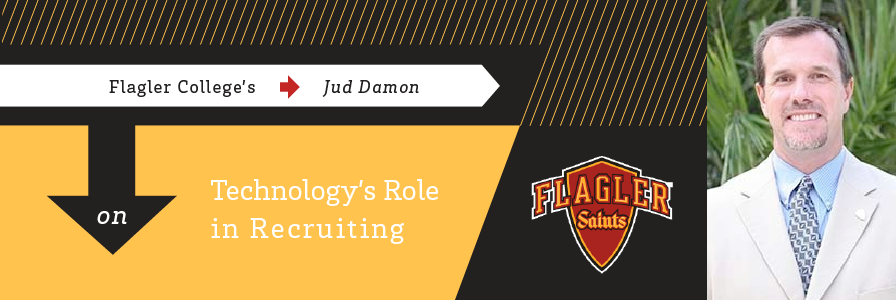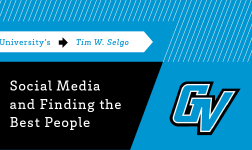 Jud Damon – Flagler College
Jud Damon – Flagler College 
Athletic Director
Jud Damon enters his 17th year as a collegiate director of athletics and his fifth year at Flagler College in that capacity. In 2012-13, Flagler was presented with its unprecedented third consecutive Peach Belt Conference Sportsmanship Institution of the Year Award after three teams: softball, women’s golf and women’s basketball were honored with team sportsmanship awards. The NCAA also recognized Damon with the Bob Frederick Award which is bestowed to one athletics director each year regardless of division who best exemplifies and encourages sportsmanship.
Ryan Matthews, Winthrop’s Managing Editor, chatted recently with Jud about technology’s role in recruiting and leading at different NCAA division levels.
What is one challenge that you’ve overcome at Flagler College and one future challenge you see you’d like to surmount?
When I arrived at Flagler College in the summer of 2009, we only had one year of full NCAA Division II membership under our belts and were just on the verge of becoming members of the Peach Belt Conference. Flagler College had left the NAIA in 2006. Thus, in the summer of ’09 the institution was still very new to Division II, its philosophical approach to collegiate athletics, and the standards of the NCAA. This presented many motivating challenges for me, particularly in the areas of game environment, facility needs, branding, competitive expectations, financing, and the overall student-athlete experience.
While we have strived to meet or overcome all of the challenges, some of them persist. One in particular, however, that we can say we have overcome is the issue we faced regarding the lack of locker rooms at our outdoor athletics complex. Our complex includes baseball, softball, and soccer facilities and is located about two miles away from our main campus. The complex had housed Flagler athletics fields for about thirty years, but did not have any dressing rooms for our four teams (and visiting teams for those sports) that compete there – baseball, softball, men’s and women’s soccer. The layout of the complex also made ticketing and game operations very difficult to say the least. The parking area primarily consisted of an open grass field with temporary movable chain link fencing.
In the summer of 2010 we began construction on what became a $3.1 million project that included beautiful locker rooms for each of our four teams, a dressing room for officials, a state-of-the-art athletic training room, a well-landscaped and well-lighted parking lot, an attractive entrance to the facility, and new fencing all around, greatly improving ticketing operations and game management. The project was completed in time for the start of the 2011 baseball and softball seasons. It addressed a major need for our programs and has had a positive impact on a variety of fronts – not the least of which are recruiting, game operations, and the overall student-athlete experience at Flagler College. Here is a link to the finished product.
There really are three significant challenges that I would like to see us surmount in the coming years. The first is in regard to the number of athletics scholarships that we provide. We are currently near the bottom of our conference in this regard. While we strive to “maximize our potential and overachieve,” the reality remains that we cannot consistently compete for championships or be nationally competitive in all of our sports if we do not improve in this area.
The second is in regard to staffing. We have only two staff members, including myself, who are truly full-time athletics administrators. Our operations and initiatives, whether they are related to marketing, fundraising, game management, community involvement, leadership of staff, or otherwise, will not be at the level we would like until we are able to bolster our administrative infrastructure.
The third challenge facing us is a sub-par basketball facility. A comparison study of the facilities in our conference revealed that the difference between our facility and others in the conference—in terms of size, age, quality, and amenities—is glaring. This facility negatively impacts our recruiting, our student-athlete experience, our game environment, and our fan experience. Construction of a new arena is certainly a priority and a significant challenge that we would like to surmount.
What aspect of your tenure at Flagler College are you most proud of?
Affecting positive culture change. We have worked hard to establish a culture of greatness in our department, to improve the game environment at our home events, and to enhance the representation of the institution by our athletics programs. Thanks in large part to the motivation of Rob Miller (national presenter for Bruce Brown’s PROACTIVE COACHING, Inc.), early in my tenure at Flagler College, our staff worked together to identify what we refer to as our Core Covenants. These are the values by which we want our program to be identified. We spent a lot of time determining them and spelling out “what they look like” in our everyday work lives and in competition. We decided upon Accountability, Integrity, Professionalism, Sportsmanship, and Teamwork as our covenants.
Relative to the Core Covenant of Sportsmanship, one of the action steps to which we committed was implementing innovative methods to intentionally display such good sportsmanship that Flagler College teams are distinct from others. To carry this out, each year I ask each team’s coaching staffs to work with their student-athletes to determine that year’s Sportsmanship Initiatives. As our coaches and athletes have enthusiastically carried out these plans, they have resulted in 16 Peach Belt Conference Team Sportsmanship Awards. While we did not implement these initiatives for the purpose of acknowledgement, those awards have led to Flagler College being named the Peach Belt Conference Institution of the Year for three consecutive years. I’m certainly proud of these recognitions for the college and the related 2012-13 Bob Frederick Award.
What has most surprised you during your tenure?
The great competitive success of some of our least-resourced programs. Several of our teams, while ranking near the bottom of our conference in scholarships, have won conference championships and achieved fairly high national rankings. This has happened because of the tremendous leadership and hard work of some very talented head coaches. I do believe the success of any organization usually rises and falls on leadership. Some of our coaches have achieved competitive success at a level that would seem impossible considering the resources with which they are working.
What’s your best advice for a new or hopeful AD?
My career path seems to have been quite different than many, or most, ADs. I never did serve as an assistant or associate AD, so never had the opportunity to learn under or be mentored by an experienced AD. I was “thrown into the fire” and simply tried my best to be a good leader. I began in college athletics as an assistant baseball coach at the University of Massachusetts. Then, after about five years in minor league baseball front office work and prep school coaching and teaching, I got my first college AD job at age 30 at a small, faith-based NCCAA institution (Trinity International University – South Florida Campus) where I was also the head baseball coach and assistant professor of Sport Management. After three years there, I moved on to an NCAA Division III institution (Savannah College of Art and Design – SCAD) that transitioned to NAIA after I had been three years. I was there for another five years as an NAIA school and then moved to my first NCAA Division II institution (Georgia College). After just a year at Georgia College, I came to Flagler. Now, at age 46, I am in my 17th year as a college AD and have had experiences at four different levels/affiliations (3 years at NCCAA, 3 years at NCAA Division III, 5 years at NAIA, and 6 years at NCAA Division II.) It has been a somewhat strange path, but I do think I have learned some things that might be helpful to a new or hopeful AD.
I think my best advice to them would be to remember that the best leaders are servants. If we truly have the approach to our positions that we are here to serve our student-athletes, our coaches, our campus, and our community, I believe that will be clearly evident to others. When it is evident to our constituents (donors, supporters, corporate partners, coaches, student-athletes, etc.) then high-trust relationships are built and we can lead much more effectively.
How has technology impacted the planning and the execution of goals for Flagler College?
I was fortunate to run into a baseball recruit of ours and his father in the weight room today as our head baseball coach was giving them a tour of our campus. In the course of the conversation, the father went out of his way to mention how impressed he was with our athletics web site. He said that he has found it difficult to find pictures, videos, or descriptions of other institutions’ baseball facilities on their web sites. He elaborated that being able to see our 360 tour of our locker room facility, baseball stadium, and baseball training facilities had a significant impact on his son’s decision to want to visit and seriously consider Flagler College.
We realize that technology plays a significant role in the impression that others have of our institution and our athletics programs, so we try to keep up with technological advances and tools that can be used for our advantage. Technology clearly plays an important part of the recruitment process – from the athletics web site to Facebook, Twitter, and all the rest of the social media opportunities that are available to us. So, as we establish and strive to reach the goals of our athletics program, technology continues to be at the forefront of our planning. In the example of the baseball recruit in the weight room, it may have made the difference in us securing a future Flagler College star!




